6 Best Yoga Postures For Pregnant Women
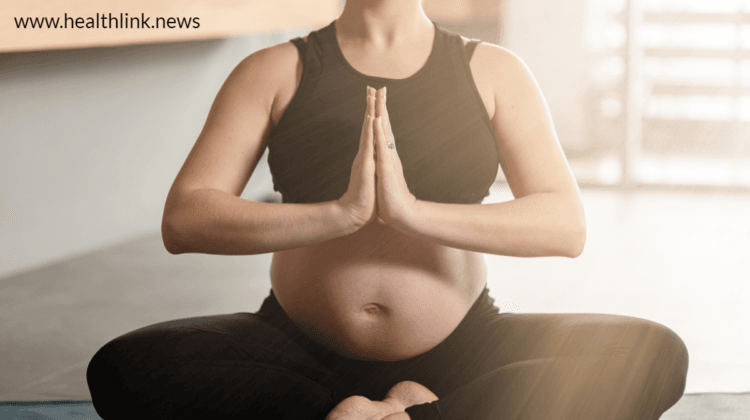
Stretching lays out numerous advantages for pregnant ladies. It can help you keep in shape, relax, and prepare for childbirth. It can also assist to relieve some of the aches and pains you may be feeling. However, there are a few things to consider before you begin. Relaxin is a hormone produced by the body. Relaxin levels increase throughout pregnancy. It aids in the relaxation of the cervix and ligaments during labor and delivery.
Relaxin also lubricates and loosens the pelvic joints and ligaments, allowing you to overstretch in activities like YOGA . As a result, stretching too vigorously can be risky, as it might result in damage. Try not to push deeper into positions than you could before you were pregnant to avoid any potential issues. Doing it Gently and slowly should be your motto if you are a beginner.
Before doing yoga in pregnant, make sure you have your doctor’s permission. Exercise could be risky if you have certain pregnancy issues.
Both the mother and the kid can benefit from prenatal yoga. Breathing techniques and gentle stretching are its main focus. These programs can help you become more flexible and ready for labor.
If you are pregnant, a prenatal yoga session in a studio or at home can be a good option. Understand the breadth of potential advantages, as well as what a typical class comprises and critical safety considerations, before beginning prenatal yoga.
Benefits of prenatal yoga
At least 30 minutes of activity per day is beneficial to both you and your baby. You do not have to work out for long periods to reap the benefits of exercise. Prenatal yoga is a low-impact workout regimen that can help you enhance your mood and sleep, strengthen, and stretch your muscles, and reduce lower back discomforts and other pregnancy symptoms.
Prenatal yoga can improve sleep, reduce stress and anxiety, increase the strength, flexibility, and endurance of muscles needed for childbirth, and decrease lower back pain, nausea, headaches, and shortness of breath. It can also:
Reduces stress and sadness and anxiety symptoms-
Depressive symptoms can be alleviated by combining focused activity and regulated breathing. Slow, rhythmic breathing activates the neurological system and prevents cortisol, which has been related to depression in excessive doses.
Improves blood circulation
Yoga’s stretches and movements help to enhance blood flow to the heart. More oxygen-rich blood is sent to your baby as blood flow improves. This ensures that your child develops normally.
It improves your labor experience
Starting prenatal yoga in any trimester can help you relax and stay happy as you prepare to give birth. During labor, meditation and breathing exercises have been proved to help with pain and anxiety. Being self-assured and honing your coping skills will also help you have a less difficult birth.
Helps you in forming a support system
Prenatal yoga courses can also improve your social life by allowing you to meet other pregnant women. Childbirth and postpartum are made simpler with a strong support system. Anxiety about the birthing process might make labor more difficult. It might be reassuring to be able to talk about your feelings and hear other people’s experiences.
A few suggested yoga poses:
Try these positions for a calming exercise that will help you manage any aches and pains you may experience while pregnant.
1. Cat-Cow
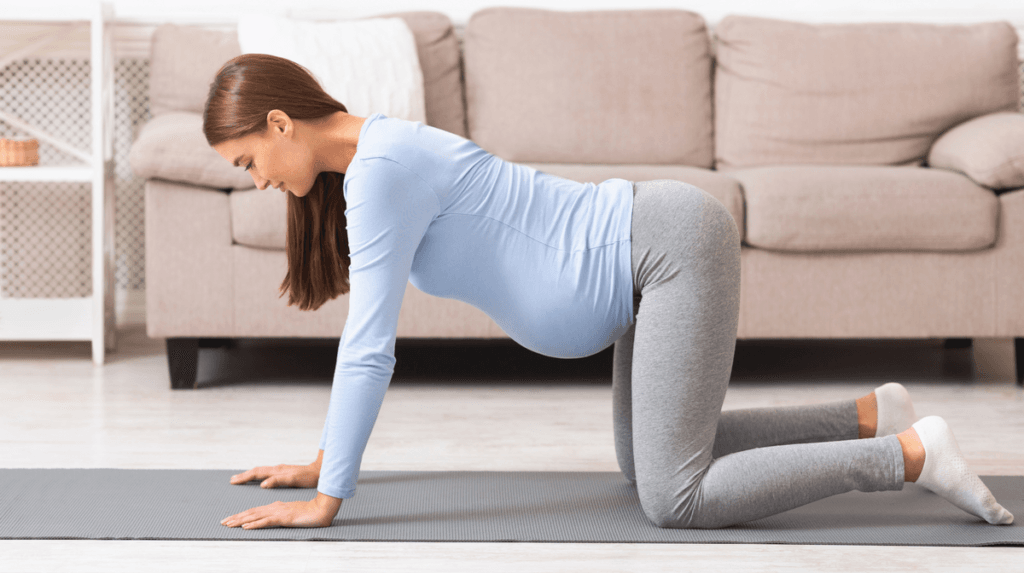
This stretch will assist to strengthen your lower back while also reducing hip and lower back discomfort and round ligament pain. It can also help to improve spine mobility. Increasing the circulation of your spinal fluid helps to keep it lubricated throughout the day. This can help prevent future discomfort while also easing existing pain.
A Yoga mat is required equipment.
Spine, arm, abdominals, and back muscles were all worked.
Begin by getting down on all fours. Maintain a flat surface on the mat with the tops of your feet, shoulders directly over wrists, and hips directly over your knees. Drop your tummy and arch your back as you inhale, but keep your shoulders rolled back and down and your gaze front and upward. This is Cow. Exhale by pressing your hands together and rounding your upper back while looking in toward your belly. This is Cat. Continue to move in an arching motion on your inhales and round on your exhales. Repeat for a total of 5 times.
2. Seated Piriformis Stretch (modified Half Pigeon)
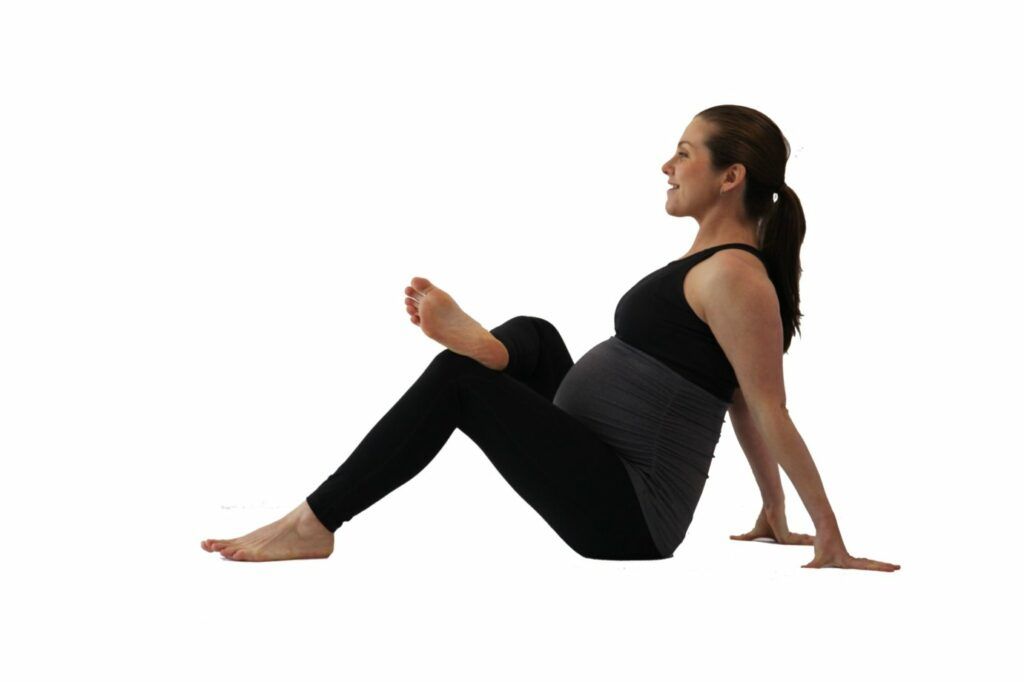
This stretch is beneficial for people who suffer from low back or sciatic pain.
During pregnancy, the piriformis muscle, a tiny muscle deep in the glutes, might spasm. Because of its tight association with the sciatic nerve, it frequently causes back and legs pain. Stretching this muscle gently can help relieve tightness and soreness.
The Chair is required equipment.
Muscles used include the spine, piriformis, and glutes.
Place your feet flat on the ground and sit in a chair. In the shape of the number “4”, cross one foot over the other knee. Slowly lean forward with a flat back as you exhale until you feel a stretch in your lower back and buttocks. Instead of curling your shoulders in toward your lap, try elongating your spine. Maintain this position for 30 seconds. Repeat on the opposite side.
3. Child’s Pose
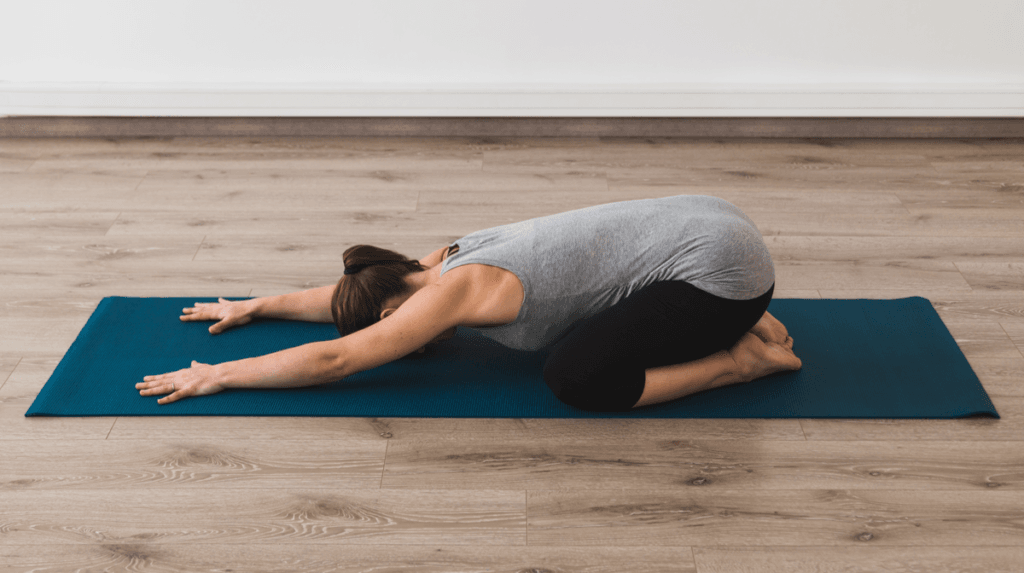
This resting stance is ideal for stretching painful hips, pelvis, and thighs softly. The spine, particularly the lower back, will be stretched as well.
Gluteus maximus, rotators, hamstrings, and spinal extensors are all the muscles that can be worked.
On the mat, start on all fours with your knees just beneath your hips. Make sure your big toes are in contact. This will allow your stomach to move between your knees and relieve pressure on your hips. If touching your toes puts any pressure on your knees or does not allow enough room for your tummy, you can widen them. Inhale and notice how your spine grows longer. Take your buttocks to your heels and lower your heads to the mat as you exhale, tucking your chin to your chest. Place your forehead on the ground and relax. If the ground is too far away, you can fold a blanket or use a yoga block to rest your head on. Maintain an outstretched arms position. At least 5 deep and steady breaths should be held.
4. Bridges Pose

Bridge gives a mild stretch for your hip flexors during pregnancy. It can also aid with the strengthening of your lower back, abs, and glutes. It will aid in the relief of hip and lower back pain.
Note that in yoga, the bridge is considered a backbend. While big backbends should be avoided during pregnancy, this moderate stretch can aid with aches and pains as well as pelvic awareness. This can help you when you are in labor.
Yoga block (optional) for restorative or more demanding positions is required.
Gluteus maximus, hamstrings, quadriceps, rectus abdominis, and hip flexors were all exercised.
Lie down flat on your back, knees bent, and feet flat on the floor. They should be around hip-width apart, although they can be further apart if it is more comfortable. Maintain a straight line of sight with your arms beside your body and, if possible, bend your legs so that your fingers can graze the backs of your heels. Curl your pelvis until your lower back is lightly pressed against the floor as you inhale, then slowly lift your hips and back off the ground, pressing evenly into your feet while maintaining a neutral spine. Hold the position for a few counts. Roll your spine back onto the ground, one vertebra at a moment, while you exhale. Make sure your spine is neutral as you relax in preparation for the next lift. The natural curve of your lumbar spine should be respected by lifting your lower back slightly off the ground. Repeat 10 more times.
5. Lunges Pose

It is a good stretch for people who have tight hip flexors, which are the muscles that run along the front of your hip. Due to changes in the location of the pelvis, these muscles might become stiff during pregnancy.
Required equipment: yoga mat or a cushion.
Hip flexors, glutes, and core muscles were worked.
Kneel on the floor, with your knees propped up on a yoga mat or a cushion for support. Step forward one step until your front knee and hip are both at 90 degrees. Slowly lean forward as you exhale, putting your weight on your front leg. By rotating your back hip forward until you feel a stretch down the front of your hip and thigh, you can square off your hips. For balance, grab a wall or a chair. Maintain this position for 30 seconds. Repeat on the opposite side.
6. Forward Fold
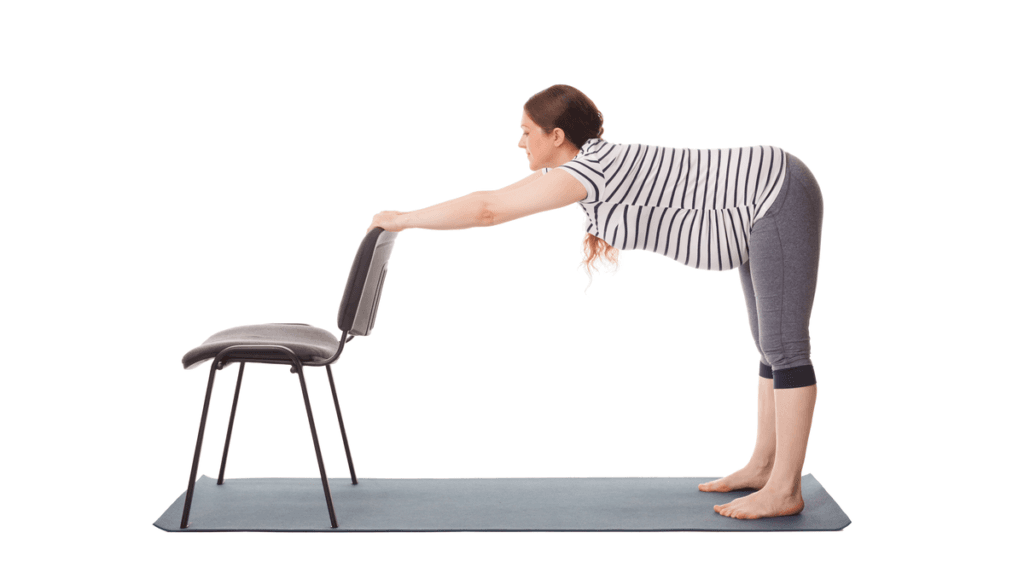
The huge muscles that run along the back of your thighs, known as hamstrings, are frequently tightened during pregnancy. Low back pain, leg pain, and poor movement patterns can all be caused by tight hamstrings.
No special equipment is required.
Hamstrings, low back, and calves are among the muscles that were worked.
Begin by standing on a mat with your toes pointed forward and your feet slightly wider than hip-width apart. Slowly lower your hands to the floor while leaning forward with a flat back. Continue until you feel a stretch in your rear legs. You can lay your hand somewhere that is comfortable for support but avoid resting it on the knee joint. Maintain this position for 30 seconds. Walk your hands over to one side, then the other, until you feel a good stretch. Repeat 3 times more.
Make an appointment with your doctor . Make sure you have your health care provider’s permission before starting a prenatal yoga practice. If you are at risk of premature labor or have certain medical concerns, such as heart illness or back difficulties, you may not be able to do prenatal yoga.
